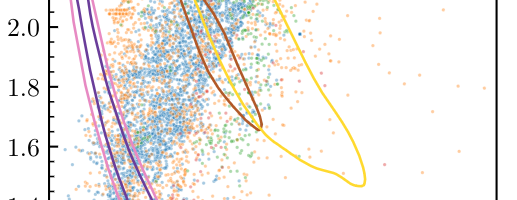From ZAMS to Merger: Detailed Binary Evolution Models of Coalescing Neutron Star-Black Hole Systems at Solar Metallicity
Zepei Xing, Simone S. Bavera, Tassos Fragos, Matthias U. Kruckow, Jaim Román-Garza, Jeff J. Andrews, Aaron Dotter, Konstantinos Kovlakas, Devina Misra, Philipp M. Srivastava, Kyle A. Rocha, Meng Sun, Emmanouil Zapartas
Neutron star − black hole (NSBH) merger events bring us new opportunities to constrain theories of stellar and binary evolution, and understand the nature of compact objects. In this work, we investigate the formation of merging NSBH binaries at solar metallicity by performing a binary population synthesis study of merging NSBH binaries with the newly developed code POSYDON. The latter incorporates extensive grids of detailed single and binary evolution models, covering the entire evolution of a double compact object progenitor. We explore the evolution of NSBHs originating from different formation channels, which in some cases differ from earlier studies performed with rapid binary population synthesis codes. Then, we present the population properties of merging NSBH systems and their progenitors such as component masses, orbital features, and BH spins, and investigate the model uncertainties in our treatment of common envelope (CE) evolution and core-collapse process. We find that at solar metallicity, under the default model assumptions, most of the merging NSBHs have BH masses in a range of 3−11M⊙ and chirp masses within 1.5−4M⊙. Independently of our model variations, the BH always forms first with dimensionless spin parameter ≲0.2, which is correlated to the initial binary orbital period. Some BHs can subsequently spin up moderately (χBH≲0.4) due to mass transfer, which we assume to be Eddington limited. Binaries that experienced CE evolution rarely demonstrate large tilt angles. Conversely, approximately 40% of the binaries that undergo only stable mass transfer without CE evolution contain an anti-aligned BH. Finally, accounting for uncertainties in both the population modeling and the NS equation of state, we find that 0−18.6% of NSBH mergers may be accompanied by an electromagnetic counterpart.

arXiv.org: 2309.09600
